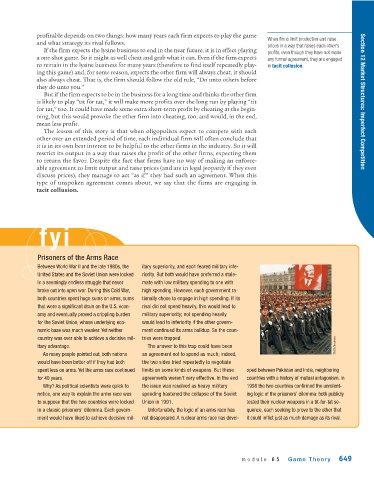Page 691 - Krugmans Economics for AP Text Book_Neat
P. 691
profitable depends on two things: how many years each firm expects to play the game
When firms limit production and raise
and what strategy its rival follows.
prices in a way that raises each other’s
If the firm expects the lysine business to end in the near future, it is in effect playing profits, even though they have not made
a one-shot game. So it might as well cheat and grab what it can. Even if the firm expects any formal agreement, they are engaged
to remain in the lysine business for many years (therefore to find itself repeatedly play- in tacit collusion.
ing this game) and, for some reason, expects the other firm will always cheat, it should
also always cheat. That is, the firm should follow the old rule, “Do unto others before
they do unto you.”
But if the firm expects to be in the business for a long time and thinks the other firm
is likely to play “tit for tat,” it will make more profits over the long run by playing “tit Section 12 Market Structures: Imperfect Competition
for tat,” too. It could have made some extra short-term profit by cheating at the begin-
ning, but this would provoke the other firm into cheating, too, and would, in the end,
mean less profit.
The lesson of this story is that when oligopolists expect to compete with each
other over an extended period of time, each individual firm will often conclude that
it is in its own best interest to be helpful to the other firms in the industry. So it will
restrict its output in a way that raises the profit of the other firms, expecting them
to return the favor. Despite the fact that firms have no way of making an enforce-
able agreement to limit output and raise prices (and are in legal jeopardy if they even
discuss prices), they manage to act “as if” they had such an agreement. When this
type of unspoken agreement comes about, we say that the firms are engaging in
tacit collusion.
fyi
Prisoners of the Arms Race
Between World War II and the late 1980s, the itary superiority, and each feared military infe-
United States and the Soviet Union were locked riority. But both would have preferred a stale-
in a seemingly endless struggle that never mate with low military spending to one with
broke out into open war. During this Cold War, high spending. However, each government ra-
both countries spent huge sums on arms, sums tionally chose to engage in high spending. If its
that were a significant drain on the U.S. econ- rival did not spend heavily, this would lead to
omy and eventually proved a crippling burden military superiority; not spending heavily
for the Soviet Union, whose underlying eco- would lead to inferiority if the other govern-
nomic base was much weaker. Yet neither ment continued its arms buildup. So the coun-
country was ever able to achieve a decisive mil- tries were trapped.
itary advantage. The answer to this trap could have been TASS/Soufoto
As many people pointed out, both nations an agreement not to spend as much; indeed,
would have been better off if they had both the two sides tried repeatedly to negotiate
spent less on arms. Yet the arms race continued limits on some kinds of weapons. But these oped between Pakistan and India, neighboring
for 40 years. agreements weren’t very effective. In the end countries with a history of mutual antagonism. In
Why? As political scientists were quick to the issue was resolved as heavy military 1998 the two countries confirmed the unrelent-
notice, one way to explain the arms race was spending hastened the collapse of the Soviet ing logic of the prisoners’ dilemma: both publicly
to suppose that the two countries were locked Union in 1991. tested their nuclear weapons in a tit-for-tat se-
in a classic prisoners’ dilemma. Each govern- Unfortunately, the logic of an arms race has quence, each seeking to prove to the other that
ment would have liked to achieve decisive mil- not disappeared. A nuclear arms race has devel- it could inflict just as much damage as its rival.
module 65 Game Theory 649

